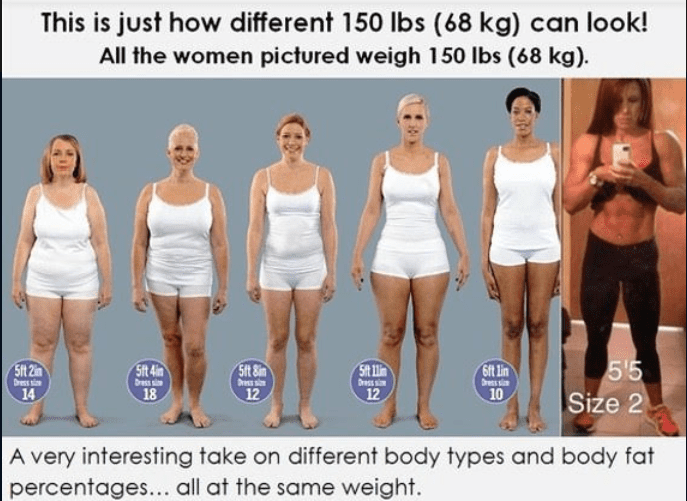Weight it’s just a number right?
For most people this number defines their lives, how they act, how they eat, and how they perceive their own bodies. Our culture has latched on to the idea that we need to be a certain weight to look a certain way or we should be that weight because of our age, height, and activity level. Unfortunately weight is a number that can deceive and trick people into being paranoid, nail-biting scale watchers. In this blog I will be covering what you should really be looking at when it comes to the way your body looks – body fat percentage and composition.
Body Fat Percentage and Composition is the number we arrive at by measuring how much of our body weight is composed of Fat Mass. There are many ways to measure this – some more accurate than others: skin calipers, bioelectrical impedance, hydrostatic weighing, DEXA, Air-Displacement Plethysmography, or 3D body scans. Any of these will give you your Body Fat Percentage.
That Body Fat Percentage will give you a true tell of what percentage of your body weight is Fat Mass and what percentage is Lean Mass. These two numbers define not only what our actual lean mass is but what our body composition may look like.
Why using weight as your only measurement tool is bad
• Your body can fluctuate 1-5 pounds a day and sometimes more. This can often be attributed to sodium, alcohol, carbohydrate intake, strength training, restroom usage, and monthly visits just to name a few.
• 150 pounds on one person looks different than 150 pounds on another
• Muscle weighs more than fat
• Below I will include some pictures of why we shouldn’t get stuck on scale weight and we should start looking at what our body composition should be our tell.
The images to the left are of the same person – even though they weigh more on the far right, you notice that their body fat has gone down.
The photo on the right shows 5 pounds of fat compared to 5 pounds of muscle. Muscle is more compact than fat as you can see in the picture.
This picture shows 6 different women all weighing the same weight. Look at how much different they are based on height, body fat, and age.
Final picture is what different body fat percentages look like
So that is what things look like visually. Below I will show you some examples of what things look like by the numbers.
—
Example #1
Individual A
1st Measurements
Individual A weighs 150 pounds and their body fat percentage is 32%
This would mean their fat mass is 150 x .32 = 48 pounds:
lean mass then is 150 pounds – 48 fat mass pounds = 102 pounds lean
2nd Measurements (one month later)
Individual A still weighs 150 pounds and now their body fat percentage is now 28%
Their fat mass now would be 150 x .28 = 42 pounds
Lean mass then is 150 pounds – 42 pounds = 108 pounds lean
Change is shown below
Individual A weight is the same 150 pounds
The Fat mass Changed from 48 pounds to 42 pounds the difference being 6 pounds fat mass loss
The Lean mass was 102 pounds and now is 108 pounds which is 6 pounds more lean mass
—
Example # 2
Individual B
1st Measurements
Individual B weighs 150 pounds and their body fat percentage is 24%
This would mean their fat mass is 150 x .24 = 36 pounds
lean mass then is 150 pounds – 36 fat mass pounds = 114 pounds lean
2nd Measurements (one month later)
Individual B still weighs 160 pounds and now their body fat percentage is now 21%
Their fat mass now would be 160 x .21 = 33.6 pounds
Lean mass then is 160 pounds – 33.6 pounds = 126.4 pounds lean
Change is shown below
Individual B weight is different a 10 pound increase
The Fat mass Changed from 36 pounds to 33.6 pounds the difference being 2.4 pounds fat mass loss
The Lean mass was 114 pounds and now is 126.4 pounds which is 12.4 pounds more lean mass
Seeing the change in fat mass and lean mass is our true tell of what is happening with your body. In individual A you notice the weight stays the same but Individual A even though not losing any scale weight loses 6 pounds in fat mass and gains 6 pounds in lean mass because their body fat has decreased by 4%.
In Individual B you notice that they gain 10 pounds in weight but lose 3% in body fat. Their lean mass increases 12.4 pounds and their fat mass only decreases 2.4 pounds but still goes down.
If your body fat is accurate then the results that you see should be accurate as well. Do not get caught looking at a scale everyday. Instead try to see if you can get your body fat% measured bi-weekly or monthly. Other ways of seeing if what you are doing, besides scale watching is to take before and after pictures and to see how your clothes are fitting.
Weight is a form of measurement indeed but remember it is not the truest and most sure fire way to see if what you are doing is truly working. The more ways you have to show your results the better picture you can paint overall for yourself.
With simple equipment and the help of a friend, family member, coach, or anyone off the street for that matter you can get a fairly accurate number of what your body composition looks like. Do it frequently and make sure you keep the way you do it as standardized as possible. And lastly don’t freak out that you weigh 3 pounds more than the day before. Everyone one of us in fact fluctuates day to day. GIve your mind a rest and get to that body fat measuring.








